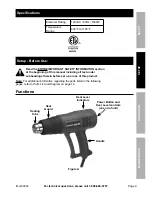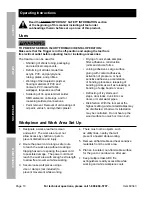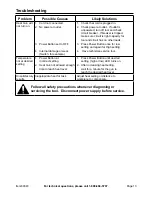
Page 4
For technical questions, please call 1-888-866-5797.
Item 69343
Sa
Fety
Opera
ti
O
n
Maintenance
Setup
power tool use and care
1�
Do not force the power tool. use
the correct power tool for your
application. The correct power tool
will do the job better and safer at the
rate for which it was designed.
2�
Do not use the power tool if the trigger
does not turn it on and off.
Any power tool that cannot be
controlled with the Trigger is
dangerous and must be repaired.
3�
Disconnect the plug from the power
source before making any adjustments,
changing accessories, or storing
power tools.
Such preventive safety
measures reduce the risk of starting
the power tool accidentally.
4�
Store idle power tools out of the
reach of children and do not allow
persons unfamiliar with the power tool
or these instructions to operate the
power tool. Power tools are dangerous
in the hands of untrained users.
5�
Maintain power tools. check for
misalignment or binding of moving
parts, breakage of parts and any other
condition that may affect the power tool’s
operation. if damaged, have the power
tool repaired before use. Many accidents
are caused by poorly maintained power tools.
6�
use the power tool, accessories and
tool bits etc. in accordance with these
instructions, taking into account the
working conditions and the work to
be performed. Use of the power tool for
operations different from those intended
could result in a hazardous situation.
Service
Have your power tool serviced by a qualified repair person using only identical
replacement parts.
This will ensure that the safety of the power tool is maintained.
Heat Gun Safety Warnings
1�
Hidden areas behind walls, ceilings,
floors, soffit boards, and other panels
may contain flammable materials that
could be ignited by the heat gun when
working in these locations.
The ignition of
these materials may not be readily apparent
and could result in property damage and
injury to persons� When working in these
locations, keep the heat gun moving in a
back‑and‑forth motion�
Lingering or pausing in one spot could
ignite the panel or the material behind it�
2�
Extreme care should be taken when
stripping paint.
The peelings, residue and
vapors of paint may contain lead, which
is poisonous� Any pre‑1977 paint may
contain lead and paint applied to homes
prior to 1950 is likely to contain lead� Once
deposited on surfaces, hand‑to‑mouth
contact can result in the ingestion of lead�
Exposure to even low levels of lead can
cause irreversible brain and nervous system
damage; young and unborn children are
particularly vulnerable� Before beginning any
paint removal process you should determine
whether the paint you are removing contains
lead� This can be done by your local health
department or by a professional who uses
a paint analyzer to check the lead content
of the paint to be removed�
LEAD BASED
PAINT SHOULD ONLY BE REMOVED BY
A PROFESSIONAL AND SHOULD NOT
BE REMOVED USING A HEAT GUN.
3�
Exercise CAUTION when using this
product outdoors.
To reduce the risk
of electric shock, keep extension cord
connection dry and off the ground�
4�
Persons removing paint should
follow these guidelines:


































